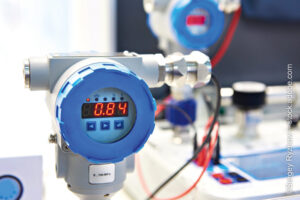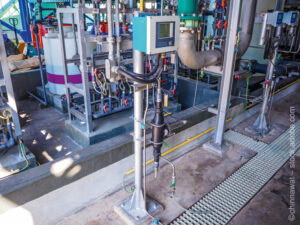Even seemingly normal operating conditions can lead to accidents. The control of process systems is usually based on the measurement of process variables such as temperature, pressure, quantity or level or certain material properties. The following accident reports show how important the correct determination of the measured variables is. Two important points should be noted before we begin. First of all, due to space constraints, the case studies highlight the causes and disregard some aspects that were definitely considered when the safety concept was drawn up or that contributed to an incorrect assessment of the situation. Second, hindsight is always clearer, and anyone might well have made the same mistakes in these situations. The use of “hindsight bias” – the distortion of an assessment that results from looking back at a past event – to assign blame quickly is unfair.
Case 1: Incorrect temperature measurement I
According to the display, the internal temperature in a reaction tank was only 100 °C despite full heating performance. Nevertheless, the operating personnel on site observed that the added solvent toluene was boiling violently, which meant that the temperature had to be 110.6 °C. The reaction batch was cooled down and the search for the cause of the false indication began.
It turned out that the temperature measurement probe had been serviced immediately before. The sensor was located in a corrosion-protection tube that should have been filled with a heat transfer medium. For unknown reasons, however, water had been used instead of the mandated thermal oil (with a high boiling point). Because the protection tube was not hermetically sealed, the water began to boil at 100 °C during the heating process, which led to the constant (false) display.
Case 2: Incorrect temperature measurement II
Leakage was detected during the leak test of a system. The leak was suspected to be in a long pipeline that was heated by two separate trace heaters. One of the two trace heaters was switched off and the insulation of the pipe section was removed so that workers could find the spot with the hole.
However, the electricity to the trace heater was not completely turned off and during the search for the leak, the insulation on some of the thermocouples on the trace heater still in operation was inadvertently stripped. Since a lower temperature was measured because of the removal of the thermal insulation, the control system increased the heating power to 100 percent. As a result, the pipeline and the insulation were heated to over 300 °C and the insulation caught fire due to the spontaneous ignition of impurities. The fire was extinguished immediately, and no further damage was caused.
Case 3: Incorrect pressure measurement

Fig. 1. Manometer for pressure monitoring. // Bild 1. Manometer zur Drucküberwachung. Photo/Foto: ©Sergey Ryzhow – stock.adobe.com
A tank that had been filled with a faulty batch required cleaning. When maintenance personnel opened the tank, the heavy hatch was suddenly blown off by the residual pressure in the tank, killing three employees. Filling with an off-spec product had led to a blockage of the vent line, which increased the pressure in the tank. The attached manometer did not register the pressure increase because the lead line was also blocked (Figure 1).
Case 4: Incorrect level measurement
Maintenance work was performed on the hybrid evaporator of an ammonia refrigeration system. At that time, a level measurement device that served as overfill protection was replaced.
When the system was restarted, the shut-off valve in the line between the hybrid evaporator and the level measurement system was left closed due to carelessness, preventing the shut-off function from working. When the system was being filled, the hybrid heat exchanger was overfilled with liquid refrigerant, resulting in a violent rupture of the compressor. Ammonia was released and 15 people were injured.
Case 5: Incorrect quantity measurement
The synthesis of an intermediate product required the placement of several components in a reaction vessel at room temperature and, with the agitator running, the bubbling of gaseous CO2 at a flow rate of approx. 100 l/min through the mixture for a limited period of time. The desired reaction, which was initiated by adding hydrogen peroxide, required a sufficient concentration of dissolved CO2, which acts as a so-called phase transfer catalyst.
On the day of the incident, the CO2 flow meter had to be replaced, at which time the maintenance personnel made a mistake. The new flow meter displayed different units of measurement than the previous one. The actual flow rate was only 8 l/min and the desired reaction did not occur because the CO2 concentration was too low. This in turn led to an accumulation of hydrogen peroxide in the reaction mixture.
When the operating personnel noticed at the end of the dosing of hydrogen peroxide that the temperature did not rise as expected, they used the heating coils to heat the reactor. This initiated the decomposition of the hydrogen peroxide and a runaway reaction took place. Temperature and pressure rose sharply and 3 t of the reaction mixture escaped via the aeration line. Personnel were able to capture the mixture in the waste water collection basin and dispose of it properly. No one was exposed to this mixture and there was no pollution outside the plant.
Case 6: Incorrect pH measurement

Fig. 2. Analyzer for pH value monitoring. // Bild 2. Messeinrichtung für die pH-Wert-Analyse. Photo/Foto: ©chinnawat – stock.adobe.com
Caustic soda was properly used to neutralise an acidic suspension and cause metallic impurities in the basic milieu to precipitate as hydroxides. The caustic soda was added via a plant pipeline network and was automatically stopped when the preset pH value was reached (Figure 2). The probes were automatically moved to the service position, where they were kept moist with rinsing liquid, when the tank level fell below 25 % so that the sensitive pH probes were protected and the correct measurement of the pH value was assured.
On the day of the incident, workers forgot to activate the pH probes, and they remained in the service position. The process control system (PCS) could not distinguish whether the measured value of the pH probes corresponded to the real process value or that of the rinsing liquid. The inactive status of the pH probes had not been defined as a malfunction, so this position was not displayed as an alarm on the PCS, and no one noticed the line operation of the measurement probes. The consequences were a significant overdosage of caustic soda and a resulting chemical reaction with the formation of hydrogen.
The subsequent increase in pressure burst the container at a pressure of about 25 bar and the contents sprayed out as if through a nozzle. The thrust that developed tore the entire container from its anchors; it broke through a solid concrete wall and pieces were violently and widely scattered over the factory premises. At the same time, the released hydrogen ignited and a violent explosion occurred. Since the employees who were in the danger zone realised what was happening in time, they were able to get to safety and nobody was seriously injured.
Conclusion
The correct determination of measured variables has an enormous influence on the safety of process equipment. Possible causes for incorrect measurements should be carefully considered in the safety concept. Special care must be taken during maintenance work to ensure that the function of the readings recorders is not impaired. Operating personnel should be trained to report implausible indications immediately.